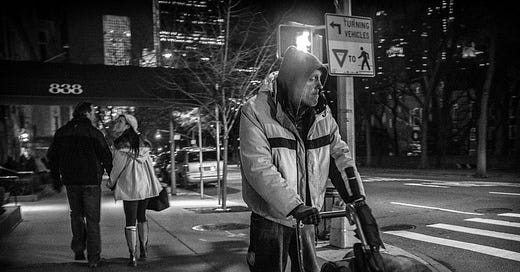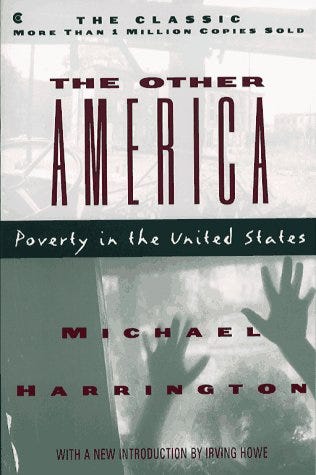Book Review of “The Other America: Poverty in the United States,” by Michael Harrington, 1963, paperback. Baltimore, MD: Penguin Books.
This is a classic—and worth reading even now!
Providing a historical context for poverty, homelessness, and starvation can help explain why these three terrible realities exist—still exist—in our society. We can explain how they started, what kept them going, and what stopped people and our government from fixing these problems. What is harder to explain is why there are not more people fighting to resolve these issues. Greed, apathy, competition, capitalism, and naivete are some of the reasons.
Perhaps a “sense of helplessness” is much more powerful than anyone realizes.
I came across this gem in a thrift shop and grabbed it! This is the book that started the "War on Poverty." Well, actually, JFK started it... but then was assassinated. So the war was waged by LBJ instead. Apparently, JFK had asked one of his staff members to start putting information together on the numbers and realities of the poor.
A wise friend just said to me: “LBJ got pushed in front of the parade and accepted the acclaim for the project.” Thank you for that historical information—or personal opinion if that’s what it was.
Even in 1962 the percentages of Americans living in poverty were amazing—in a bad way. I had no idea things were that bad then, and I did not know of the extent of the suffering. The author is very specific and very informed as he explains a lot of the difficulties faced by the poor.
Just as today, there are millions and millions of poor people in our nation. How many millions are we talking about? Lots of millions then and lots of millions now. An awful lot of people would never believe the numbers in 1960 any more than they would believe the numbers in 2025.
I will not give away a great deal of the content of this book here. Suffice it to say the book is an eye-opener. It is also an essential view into a past in which there was so very much hope emerging. They were exciting and dynamic times, indeed. There are also those great similarities in the culture of poverty (as the author says) of the 1960s and the same culture today.
It would be silly to say this book presents a view of poverty that is identical to our current growing group of poor in this nation today, but the trappings are similar. Poor people today face very similar challenges as the ones presenting to the poor in 1962. There is still a great deal of stigma associated with the poor and the homeless. And among the general public there is still a huge amount of ignorance about poverty.
I would have to say that the great majority of issues, complications, and challenges facing the poor in 1962 are the same and as powerful now. Yet there are those who would tell you we are richer, we have more technology, the country is safer, people are healthier, and the most important improvement in life is financial. Things are just “better” now, some people would try to get you to believe.
But are things better for people now, generally? Is the problem of poverty solved? Are all the homeless now housed securely and indoors—off the street, safe and sound? Is everyone fed well? Are babies sleeping in nice warm cribs instead of in a car? Are there jobs for those who want to work? The answer is of course a resounding NO to all of these questions.
The average American (who is not among the millions who are poor, homeless, evicted, disenfranchised, etc.) has little or no idea how many poor people there are in this land. There is still a great deal of ignorance about numbers of poor and reasons they are living in those circumstances.
Recently, I was talking with a stranger, waiting for the traffic light to change. We were talking about the economy, and she told me the country is becoming richer every day, and everyone is succeeding. I pointed at some people sleeping on the sidewalk, and I asked, "But what about them?" She responded, "well, they are semi-crazy, and there will always be people like that in our society.”
I did not respond. I knew I would use her explanation somewhere in writing to show the ignorance out there (and this is the second time I am using her sorry quotation).
The author claimed that if there were not some laws and policies put into place we would be writing a book on the same topic “a generation from now and it will be the same or worse” (p. 156). Funny how insightful some people are.
Well, the author is exactly right. We still have people on food stamps, sleeping on the sidewalk, losing their jobs, living one-paycheck-away-from-being-homeless, and struggling to make it. The economy is great, much better than it has ever been.
The quality of the tents of the homeless along Lake Shore Drive speaks to the increase in wealth.
Reading this book is a frustrating endeavor, because we get from the author an explanation of what is needed to solve the problems of poverty in the USA (p. 170). A combination of acts and debate must kick in for the solutions to come about.
Reading this book is also a timely endeavor, indeed, and it is frightening to think that there are some people out there who do not get it, who do not care if some people have to work even though they are not getting a paycheck, and who do not see the poor because they consider them invisible.
We will see what happens under the new administration. In the meantime, we still have to hand out those gloves, protect our unhoused brothers and sisters, try to get people housing (Housing First!) as we find dollars to do so, and pray for our society.






